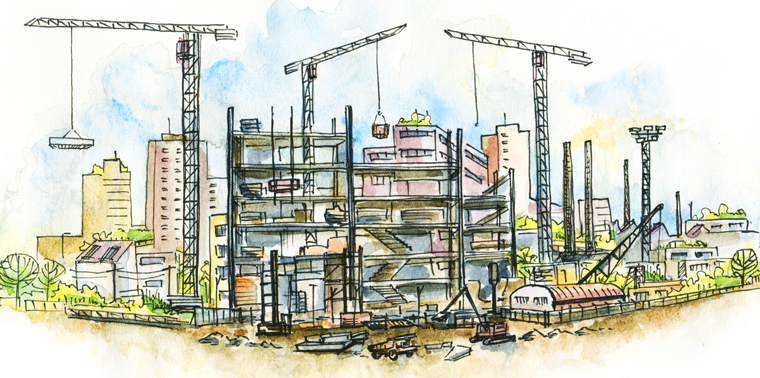October 31, 2017 — Three record-breaking hurricanes recently cut a swath of devastation through the Caribbean and southern United States. The economic and human toll has dominated the headlines, and rightfully so.
Nowhere is that more evident than in the tragedy unfolding before our eyes in Puerto Rico. After hurricane-strength winds lashed at the island’s critical infrastructure, most of the 3.4 million Americans who live there lost access to the power, food and clean water that make daily life possible.
Providing those still in need with emergency food, water and shelter must be our top priority. But over time, as attention shifts from the immediate humanitarian response to fully assessing the social, economic and environmental impacts of the disaster, we need to keep nature in mind.
Ignoring the environmental implications of disasters risks leaving communities more vulnerable in the future. If we make environmental planning a pillar of our disaster recovery strategies, however, we can rebuild safer and smarter, leaving communities stronger and more resilient to future shocks.
Subtle Threats
Some examples of environmental damage in the wake of disaster — like the 28 million gallons (106 million liters) of sewage that Hurricane Irma spilled across 22 counties in Florida, or the 13 toxic waste sites in the Houston area that were flooded or damaged — are hard to miss. But other threats can easily fly under the radar. And while it will likely be months before we can fully assess the damage wrought by this unprecedented hurricane season, history offers plenty of examples.
In 2005, hurricanes Katrina and Rita together destroyed or damaged more than 320 million trees — the single largest loss of forest resources in U.S. history. As those trees died off, they released more than 100 million metric tons (110 million tons) of carbon into the air. Such large-scale deforestation creates a perilous feedback loop. More greenhouse gases in the atmosphere accelerate the process of climate change, and climate change — while not necessarily the cause of any single hurricane — indisputably contributes to more extreme hurricanes and other weather events. The result? An increasing number of weather-related events like floods, mudslides and wildfires, putting a growing number of people in harm’s way.
Although reducing impediments to a speedy reconstruction is understandable, it can have unintended consequences. A second subtle threat is the relaxation of environmental regulations in the wake of a disaster. Although reducing impediments to a speedy reconstruction is understandable, it can have unintended consequences. Suspending regulations on the clean-up of industrial solid waste, wastewater and debris can pose an immediate risk to human health and safety. Environmental degradation due to lowered standards during clean-up also harms a community’s long-term development. Debris dumped in mangroves, marshes and wetlands can inflict damage on ecosystems that provide food and clean water, sustain fisheries and tourism, and serve as crucial natural barriers to storm surges.
After the initial clean-up comes the long rebuilding process. When communities engage in large-scale rebuilding, they are often trying to rebuild in a few months or years what may have taken generations to build in the first place. Rebuilding at this pace can result in the unsafe extraction of large quantities of raw materials like timber, sand and clay: In the aftermath of the 2004 tsunami that impacted a large swath of Asia, for example, the replacement of infrastructure in Indonesia alone required more than 1 million cubic meters (roughly 400 million board feet) of sawn timber.
A Better Way
How can we ensure that our responses to disaster protect nature and the benefits it provides?
Post-disaster impact assessments should factor in the effects on the environment of both the disaster and the rebuilding process. First, post-disaster impact assessments should factor in the effects on the environment of both the disaster and the rebuilding process. When Chile and Nepal experienced massive earthquakes in 2010 and 2015, respectively, both nations incorporated rapid environmental assessments into their post-disaster evaluations — to understand how forests, riverbeds, coastal embankments and other key areas were impacted. Then they moved quickly to include ecosystem restoration in their rebuilding efforts. The Chilean residents of Mocha Island, for example, restored and protected their beaches and forests — and in doing so, they supported ecotourism development that put people back to work.
Second, we should “build forward” with 21st century clean energy systems that reduce future risk and costs. That’s what the residents of Greensburg, Kansas, did after a tornado destroyed 95 percent of the community’s buildings in 2007. They set sustainable rebuilding goals and incorporated wind, solar and geothermal energy into their reconstruction plans. Within six years, Greensburg had the most LEED-certified buildings per capita in the world.
Third, we should make use of natural and green infrastructure. This can minimize the need for engineering, build the flexibility and redundancy needed for long-term resilience, and reduce construction and maintenance costs. When tropical storm Stan caused flooding and mudslides along the border of Mexico and Guatemala in 2005, affected communities responded by diversifying their farming systems, terracing degraded slopes to reduce soil erosion and surface runoff, and integrating tree planting into their agricultural practices. Similarly, in the wake of Katrina, New Orleans has been investing in rain gardens to absorb floodwater and keep it away from people’s homes. And following Superstorm Sandy, New York City building codes were updated to include required elevation in areas vulnerable to flood risk. In Staten Island, wetland ponds were constructed to hold and filter stormwater drainage in areas where municipal storm drainage did not exist.
Fourth, communities should, to the extent possible, use building materials that are sourced in an environmentally and socially responsible way. Rebuilding “safer and greener” is critical for protecting both people and the natural capital that could prove indispensable if disaster strikes again.
Fifth, properly reusing, repurposing and recycling debris helps protect habitats, drinking water and more from harm. A post-Katrina debris management study conducted by the U.S. Army Corps of Engineers concluded that debris can be a resource for rebuilding roads and buildings. And recycling debris can minimize problematic materials and landfill waste. Vegetative material typically makes up a substantial portion of debris generated during a large storm, so the agency recommended that all storm-related debris recovery plans include vegetative recycling (the use of vegetation for compost, mulch and landfill cover, among other things).
These green practices together can help communities rebuild stronger and safer, while protecting the environment, improving efficiencies and cutting costs at the same time. At the heart of a green approach to disaster response is an essential but often undervalued truth: By building with nature, and using the assets that nature provides in a balanced way, we can build a more resilient future — for our planet and for ourselves. ![]()
Editor’s note: The views expressed here are those of the author and not necessarily of Ensia.
Ensia shares solutions-focused stories free of charge through our online magazine and partner media. That means audiences around the world have ready access to stories that can — and do — help them shape a better future. If you value our work, please show your support today.
Yes, I'll support Ensia!
